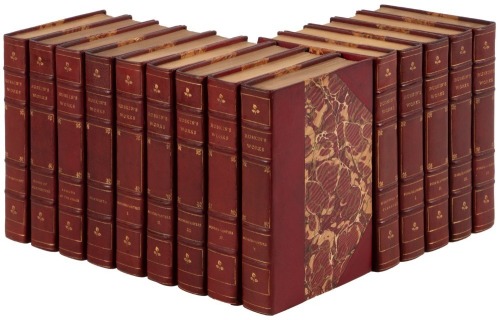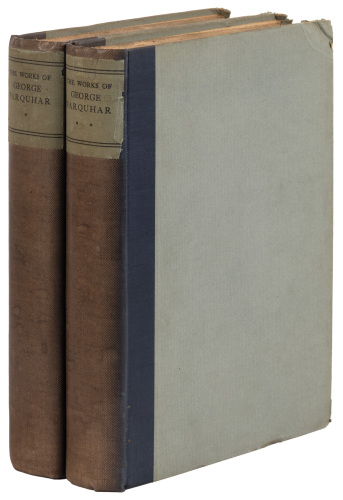DE LA CRUZ, Sor Juana Inés (1651-1695). Poemas de la Unica Poetisa Americana, Musa Dezima. Madrid: Imprenta Real for Joseph Rodriguez de Escobar, 1714 [With:] –. Obras Poeticas de la Musa Mexicana. Madrid: Imprenta Real for Joseph Rodriguez de Escobar, 1715 [And:] Fama, y obras posthumas del fenix de México, dézima musa, poetisa Americana, Sor Juana Ines de la Cruz. Madrid: Antonio Gonçalez de Reyes, 1714. A complete set, in a contemporary uniform binding, of the works of Sor Juana, also known as the “Tenth Muse” and the "Mexican Phoenix," an early edition. Sor Juana was a Mexican philosopher, poet, playwright, book collector, and nun who is one of the most important figures of the Spanish Golden Age—and certainly the most important from Latin America. The illegitimate daughter of a Spanish captain, Juana grew up in San Miguel Nepantla at her maternal grandfather's hacienda among his considerable library. Eschewing marriage, she entered a Hieronymite convent in 1669. Skilled in both Latin and Nahuatl as well as theology and logic, her radical thinking on church hierarchy and women's roles caused the Catholic Church to publish a letter in 1690 demanding that she focus on prayer rather than philosophy. She was eventually forced to sell her extensive library of some 4,000 volumes as well as her musical and scientific instruments—one of the largest in New Spain. Plague struck her convent in April 1695, and Sor Juana was among the many victims. Sor Juana’s poetry is written in Spanish, Latin, and Nahuatl, and her work across genres engages with both contemporary and ancient philosophical traditions. In addition to her religious poetry, she wrote many secular works on commission from the court, including comedies and love poems. Her two most famous works today are the Primero sueño, a long Neoplatonist poem written in an original and learned style, and the Respuesta a Sor Filotea de la Cruz, her defense of women’s rights and education. The extremely rare first edition of her work was published in 1689-1700 in Spain, cementing her reputation across the Atlantic as well. Her bibliography is not well studied, and many editions so rarely found complete that they are not well understood. Only the third volume of the first edition has appeared at auction in the last 50 years, and the various editions of her complete works are more often encountered piecemeal than together. The third volume of the present edition is sometimes, as in Sabin, recorded in bibliographies as a separate publication because it is so rarely found with its first two volumes. This is an attractive copy of a set usually only encountered in individual volumes, the complete works of the most important Latin American poet of the Colonial Era. Palau 65230, 65232, and 65334; Sabin 17733 and 17735. Three volumes, quarto (210 x 144mm). Woodcut ornament on title page, woodcut head and tailpieces, factotum initials in vol 3 (a few small closed tears, paper flaw affecting printed page number in vol 2, browning). 18th-century mottled calf, spine gilt in compartments, marbled endpapers, red edges (restored, with newer gilt decoration added to the boards).
DE LA CRUZ, Sor Juana Inés (1651-1695). Poemas de la Unica Poetisa Americana, Musa Dezima. Madrid: Imprenta Real for Joseph Rodriguez de Escobar, 1714 [With:] –. Obras Poeticas de la Musa Mexicana. Madrid: Imprenta Real for Joseph Rodriguez de Escobar, 1715 [And:] Fama, y obras posthumas del fenix de México, dézima musa, poetisa Americana, Sor Juana Ines de la Cruz. Madrid: Antonio Gonçalez de Reyes, 1714. A complete set, in a contemporary uniform binding, of the works of Sor Juana, also known as the “Tenth Muse” and the "Mexican Phoenix," an early edition. Sor Juana was a Mexican philosopher, poet, playwright, book collector, and nun who is one of the most important figures of the Spanish Golden Age—and certainly the most important from Latin America. The illegitimate daughter of a Spanish captain, Juana grew up in San Miguel Nepantla at her maternal grandfather's hacienda among his considerable library. Eschewing marriage, she entered a Hieronymite convent in 1669. Skilled in both Latin and Nahuatl as well as theology and logic, her radical thinking on church hierarchy and women's roles caused the Catholic Church to publish a letter in 1690 demanding that she focus on prayer rather than philosophy. She was eventually forced to sell her extensive library of some 4,000 volumes as well as her musical and scientific instruments—one of the largest in New Spain. Plague struck her convent in April 1695, and Sor Juana was among the many victims. Sor Juana’s poetry is written in Spanish, Latin, and Nahuatl, and her work across genres engages with both contemporary and ancient philosophical traditions. In addition to her religious poetry, she wrote many secular works on commission from the court, including comedies and love poems. Her two most famous works today are the Primero sueño, a long Neoplatonist poem written in an original and learned style, and the Respuesta a Sor Filotea de la Cruz, her defense of women’s rights and education. The extremely rare first edition of her work was published in 1689-1700 in Spain, cementing her reputation across the Atlantic as well. Her bibliography is not well studied, and many editions so rarely found complete that they are not well understood. Only the third volume of the first edition has appeared at auction in the last 50 years, and the various editions of her complete works are more often encountered piecemeal than together. The third volume of the present edition is sometimes, as in Sabin, recorded in bibliographies as a separate publication because it is so rarely found with its first two volumes. This is an attractive copy of a set usually only encountered in individual volumes, the complete works of the most important Latin American poet of the Colonial Era. Palau 65230, 65232, and 65334; Sabin 17733 and 17735. Three volumes, quarto (210 x 144mm). Woodcut ornament on title page, woodcut head and tailpieces, factotum initials in vol 3 (a few small closed tears, paper flaw affecting printed page number in vol 2, browning). 18th-century mottled calf, spine gilt in compartments, marbled endpapers, red edges (restored, with newer gilt decoration added to the boards).















Testen Sie LotSearch und seine Premium-Features 7 Tage - ohne Kosten!
Lassen Sie sich automatisch über neue Objekte in kommenden Auktionen benachrichtigen.
Suchauftrag anlegen